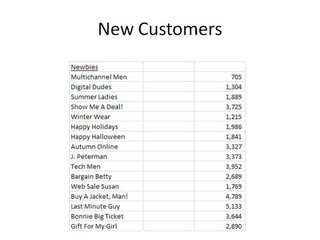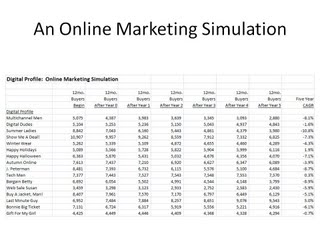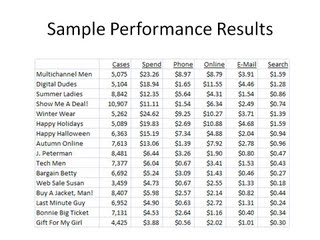Dear Catalog CEOs: A Failure To "Be Online"
Dear Catalog CEOs:
Here's a question that I'd like for you to answer with honesty.
"Do you truly have an online channel?"
More on the answer to the question in a moment.
See if you believe the early results from Internet Retailer:
- Online Pure-Plays (Excluding Amazon) experienced +18% e-commerce growth last year.
- The overall average growth rate for an online business was +14%.
- Catalog brands averaged -3% growth in the online channel.
We failed to capitalize on our huge e-commerce head start.
A decade ago, we had the infrastructure in place to fill orders efficiently, and we were ahead of the curve in the adoption of e-commerce and e-mail marketing.
A half-decade ago, we were behind the curve in the adoption of search marketing. In many cases, we made up some ground via paid search ... of course, we had to "pay" to catch up.
Today, we're waaaaaaayyyyy behind the curve when it comes to online marketing.
See, we spent our time believing the multi-channel script provided by a vendor community with a vested interest in publishing a multi-channel script. We were told that all customers shopped because they received catalogs and then placed orders online.
Today, we've lost a ton of market share. We focus solely on the customers who shop because they received catalogs. We failed to pay any attention to the 18-45 crowd, folks who shop very different than the baby boomer generation that took cataloging to a whole new level. We simply shut out the portion of the consumer audience that will generate business in the future. I get concerned anytime I hear a quote like "80% of our online audience matches back to a catalog" ... that is a symptom of failing to focus on the 18-45 crowd.
Today, we view co-op marketing as a best practice. We give our most valuable asset, name & address, away to a co-op for free. We then pay the co-op money for access to other names. We then put expensive paper in the mail to an ever-shrinking audience of baby boomer customers who like to shop that way.
Conversely, our online competition realizes that those same customers are available ... for free, online.
Why didn't we pursue the "free" option?
Modern e-commerce is rapidly moving in three different directions.
Direction #1, From Retailers: Retailers have finally realized that if you're going to have a retail channel that is saddled with crippling debt, you may as well use that channel to facilitate a multi-channel experience. Through 2009, retailers used e-commerce and direct marketing as a way to drive store traffic. In the next five years, you will see retailers do the opposite --- they will use their stores to fuel e-commerce growth. You'll see mobile apps that a customer uses when she doesn't find the item she's looking for in the store --- she'll use her smartphone to simply place an e-commerce order with free shipping and two-day delivery. Ding! And the sale will be attributed back to the store via geo-targeting on the mobile app, helping Management leverage the crippling weight of debt acquired during the first decade of the century when the pundits said you have to leverage yourself to the limit in order to capitalize on bricks-'n-clicks. For retailers, direct marketing is moving away from the website and direct mail and e-mail ... it is moving to a combination of social media, social networks, and to mobile marketing via the smartphone.
Direction #2, From Pure Plays: The online pure play will resemble a fusion of interactive television, social networking, and e-commerce. The concept of static websites and landing pages is long over. It is being replaced by the concept of an "entertainment network" ... think of your online brand as a media conglomerate that produces video programming, radio/podcast programming, written content, reality and lifestyle "shows", all deeply integrated with social networking, search, mobile, and e-commerce. It's a big festival of branding excellence! You'll interact with somebody on Facebook after watching your favorite "television show" produced by the pure play, ultimately purchasing merchandise on your smartphone via a social network that doesn't exist today but will have 100,000,000 users in 2013, purchasing merchandise that is delivered in two days with free shipping and free returns. The pure play can invest in this future, because it doesn't have 25% of net sales locked up in catalog marketing, and because it doesn't have the crippling debt of the bricks-'n-clicks retailer. Hint --- financial freedom will greatly benefit the online pure play.
Direction #3, From Catalogers: Here's your chance to shape the future. This can go one of three different directions, really. We can be like Miles Kimball, who publicly stated that they are well-positioned for growth as the baby boomer generation ages into the Miles Kimball target demographic. That is a strategy that "could" work for another ten or fifteen years. Or we can decide to keep sending catalogs via the traditional catalog marketing model of the 1990s until there are a few hundred thousand people left who prefer that method of commerce. Or maybe, just maybe, there is something that can be learned from retailers and online pure plays, based on where they are heading, something that can be adjusted to fit the catalog model.
Fortunately, we get to pick our future. One thing is certain, however. If we want folks under the age of 45 to purchase from us, we are going to have to "be online". This is different proposition than "having a website".
As always, you may contact me with your questions and concerns.
Thanks,
Kevin
Labels: Dear Catalog CEOs





